Above: The cover for The Chupacabra Ate the Candelabra.
I love Ana Aranda’s work, and I especially love her incredible color sense. She embraces purple and pink, and makes these colors feel sophisticated and fresh in a way I haven’t seen before. (Look at that amazing palette on the cover!) Today I talk to her about her U.S. illustration debut, The Chupacabra Ate the Candelabra.
The Scoop on Ana Aranda
Hometown: Mexico City
Now lives in: San Francisco
Tools of the trade: Winsor & Newton gouache, watercolor, and inks; Dr. Ph Martin inks; masking fluid; kraft tape; cold press watercolor paper.
Illustration idols: Shaun Tan, Moebius
Caffeine of choice: Radiohead or a really cool playlist
Workspace: I work in an art studio in the Mission District of San Francisco
Cat or dog? Dog
Favorite children’s book
…as a child: I loved the “Barco de Vapor” books in Mexico
…as an adult: “The Arrival” by Shaun Tan
Creative influences: My first influences were Mexican muralist painters such as Rufino Tamayo and David Alfaro Siqueiros, as well as surrealistic painters such as Leonora Carrington and Remedios Varo. These days I love looking at illustrations that have a fantastical and whimsical feel, such as those of Beatrice Alemagna, Benjamin Chaud, Oliver Jeffers, Claude Ponti, Shaun Tan and many, many more!
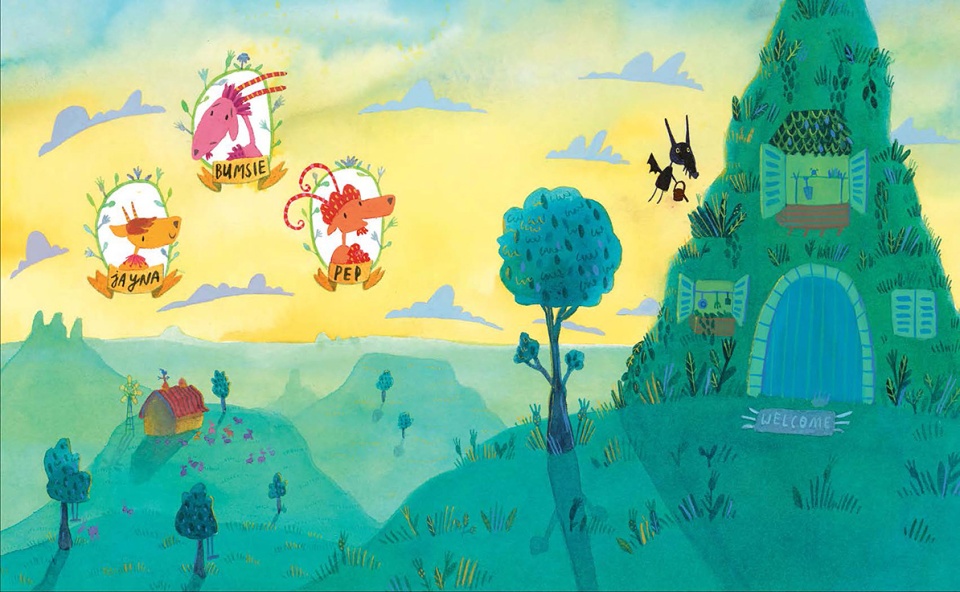
The opening spread for The Chupacabra Ate the Candelabra, written by Marc Tyler Nobleman and illustrated by Ana Aranda. This spread and the two below set the scene for the rest of the book, which takes place between sunset and sunrise.

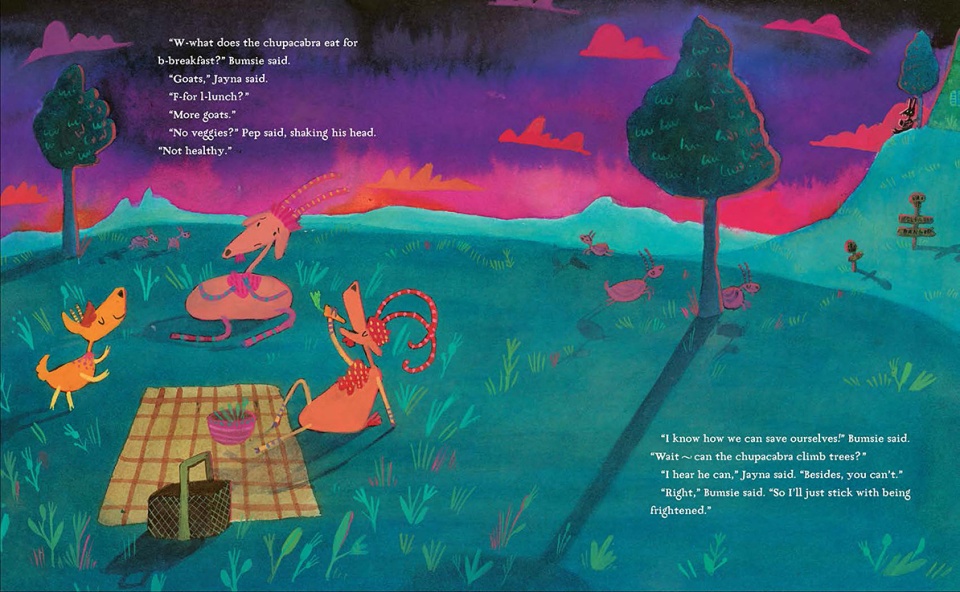
Robin: You met Art Director, Cecilia Yung, during our portfolio mentorship program at the SCBWI LA 2014 Conference. Is that how Cecilia found you for this project?
Ana: I had met Cecilia in the summer of 2014 thanks to the SCBWI Mentorship program and later that year I started working with my agent, Adriana Dominguez. Cecilia contacted me with the manuscript and I instantly fell in love with the story and was very happy to have the opportunity to work on a character that I’ve known since I was very young. I was also really happy to work with Cecilia and the amazing team with Nancy Paulsen!
Robin: Take us through your process for the artwork for Chupacabra. What happened from the time you read the manuscript to completion of finished artwork?
Ana: After reading the manuscript many times, I started working on the chupacabra and the goats character designs. I usually work on sketches in black and white and color. When all the character designs were figured out, I studied the environment and later worked on a black and white dummy. The dummy was very fun to make because I wanted every page to tell a story and let us know more about the character, from the moment when the Chupacabra wakes up, until the moment when it has eaten everything the stomach can handle.
After the sketches were approved I did color sketches to explore the time of day and different color layouts. The last step was to create the final paintings, having lots of fun!
Robin: What media did you use to create the final pieces in the book?
Ana: The pieces for this book were created in watercolor, ink, and gouache on watercolor paper. In one illustration in particular I also added cochineal, spices and fresh squeezed orange juice. Cochineal is a rare bug that lives in cacti and which produces a crimson-like dye.

Left: Dried cochineal. Cochineal is an insect that lives in cacti. It can be used to make a natural, deep crimson dye. Right: Ana also used Tajin seasoning and orange juice in her painting.

Details from the final spread in TCATC where Ana painted with cochineal, orange juice, and spices. (We can’t show you the whole spread because it gives away the ending!) “I decided to use this precious material for one spread only… I squeezed an orange on a recipient and splashed it on top of the cochineal with a toothbrush and then sprinkled… Tajin powder chili on top.”
Robin: Tell us more about the spread you painted with bugs! What, why, and how?
Ana: I’ve always found [cochineal dye] fascinating, as it is used by many printmakers and painters in Mexico.
It wasn’t until 2012 that I learned more about the technical aspects of it when I was a tour guide for a show called “The Magic Surrealists of Oaxaca, Mexico. Rufino Tamayo’s Legacy: Contemporary Zapotec Artists”. In this show some of the pieces were done with this technique and I learned that when you apply an acid element, like lime or orange juice [to the cochineal dye,] the carmine/purple color will turn towards the red and orange side of the color wheel and if you add a basic element, like bleach, it will turn towards the blue and green side. I loved this and had been wanting to apply it for a long time in my art.
While I was working on the Chupacabra book, the most amazing coincidence happened and I got hold of some of these bugs and dye from my studio mate’s friend, who became my hero!
I decided to use this precious material for one spread only, where food was the main element, and then add acid elements to it. I squeezed an orange on a recipient and splashed it on top of the cochineal with a toothbrush and then sprinkled one of my favorite spices on top—Tajin powder chili which has a lot of lime. This created a very interesting visual texture mixed with the ink/watercolor washes that I had never used in my work before.
Robin: Can you explain a little bit about how you use it? Do you grind the cochineal then mix it with water?
Ana: For these images I had a dye of the cochineal in hand that someone else had already created. Unfortunately I am not an expert on how to create this mix but would love to learn more!
[P&O note: Here’s a video that talks more about cochineal bugs and the acid/base effect.]
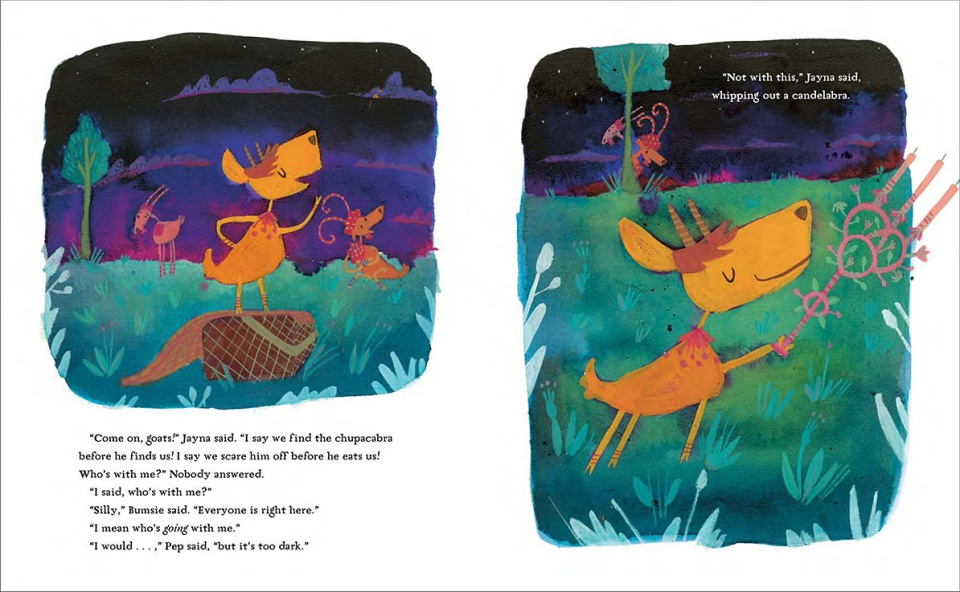
A final spread from The Chupacabra Ate the Candelabra. “When I paint, I like to build the darkest tones first and then go from dark to light, this has always felt more natural to me than going from light to dark. “

A final spread from The Chupacabra Ate the Candelabra.
Robin: I’ve always admired your unique, well-edited color palettes, and the palette you’ve selected for this book is gorgeous. How do you develop your color palettes? Are there certain things you look to for inspiration? Do you decide on a palette at the beginning or is it more organic?
Ana: Thank you so much, it means a lot to me! For this book the different times of day defined how the palette would change. Color is one of the first things that I think about when I’m starting a book: which colors represent the feeling of the book, and how I can play with them to create something unique. I like to think that every time you turn the page, you discover a different color experience, and that the colors create an emotional experience.
I love playing with cold versus warm colors. Because of this I decided to paint the chupacabra with purple, as it is a color that could fade a little bit with the cold colors in the background, but not too much so that people would still find it. The goats on the other hand had to have a warm and more saturated palette so that they would pop out next to the colder colors in the background.
Robin: I also love your use of black. Can you talk more about that? Do you use black as an underpainting and if so where and how?
Ana: Having night scenes was a great opportunity to play with darker tones and to have the character’s colors pop out!
When I paint, I like to build the darkest tones first and then go from dark to light, this has always felt more natural to me than going from light to dark. After painting the darkest tones with watercolor, inks, or even India ink, I use gouache on top for the highly saturated and brighter details. It is a great technique for intricate lines and also for bigger graphic shapes with a nice brushy feeling where we can still see some of the underpainting. I also like to play a lot with frames. For the spot illustrations in this book, I used the negative space to let us know more about the environment (floral and organic patterns, barn, etc).
Robin: The colors printed soooo beautifully. Can you tell me more about that?
Ana: I LOVE how the book printed!! A very important part of my work is color and I was so happy to have such an amazing team that helped make the colors as true as possible to the real illustrations, on a beautiful matte paper! (Big thanks to my art director, Cecilia [Yung]!) There were several rounds of color proofs, and the whole process was very meticulous and so enjoyable! Some of the colors (especially the saturated pinks and reds) are very hard to scan and to print and they look just as vibrant in the book as they do in my original illustrations.

Character sketches for the chupacabra. “I focused on designing a character that would be scary and mysterious, but funny at the same time.”

Another early chupacabra study.
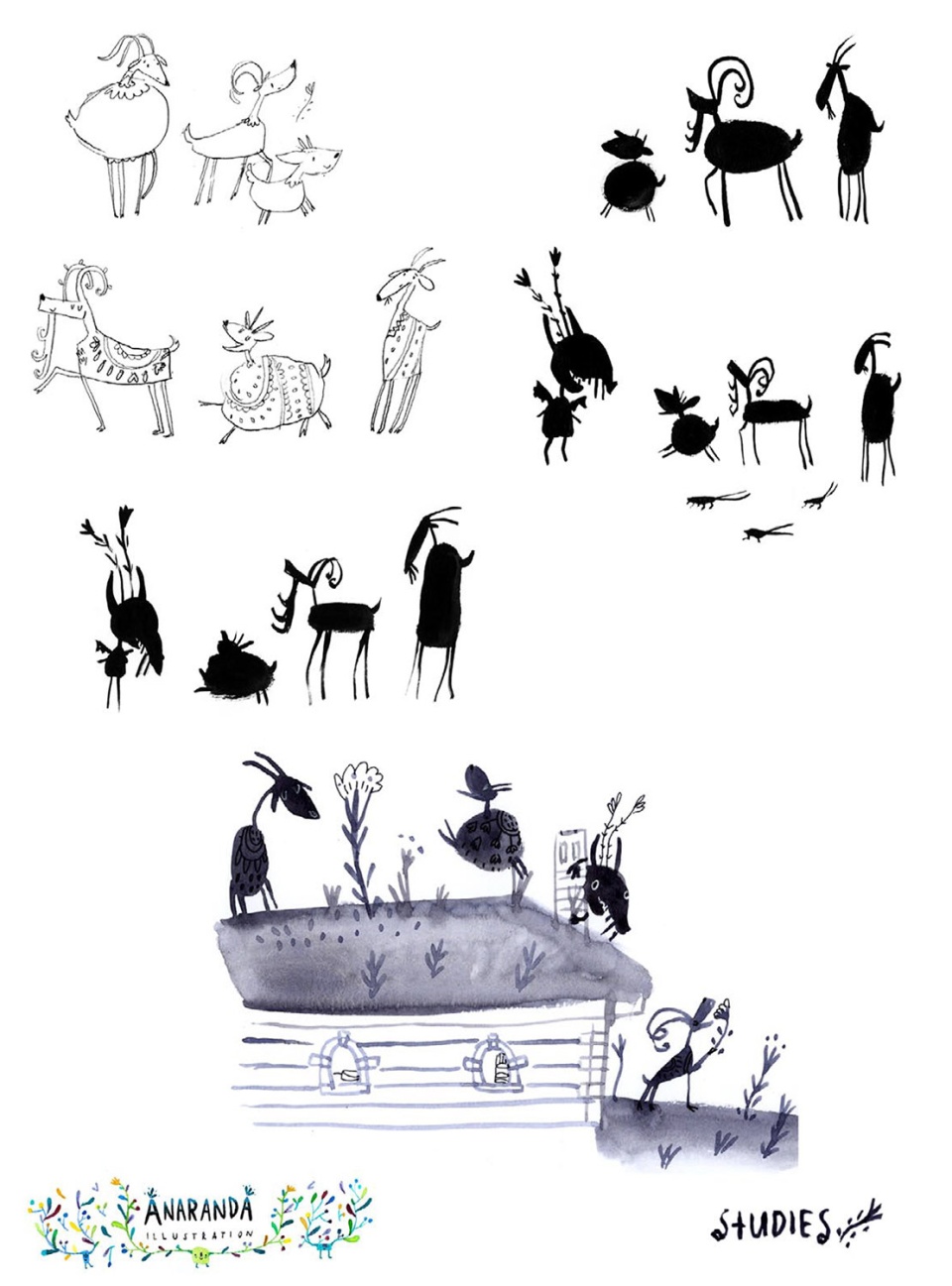
Some early goat studies. “When working on character studies I like to work on their silhouettes first. This helps me know if they are recognizable with basic graphic elements, if their shapes are asymmetrical, dynamic and interesting overall.”
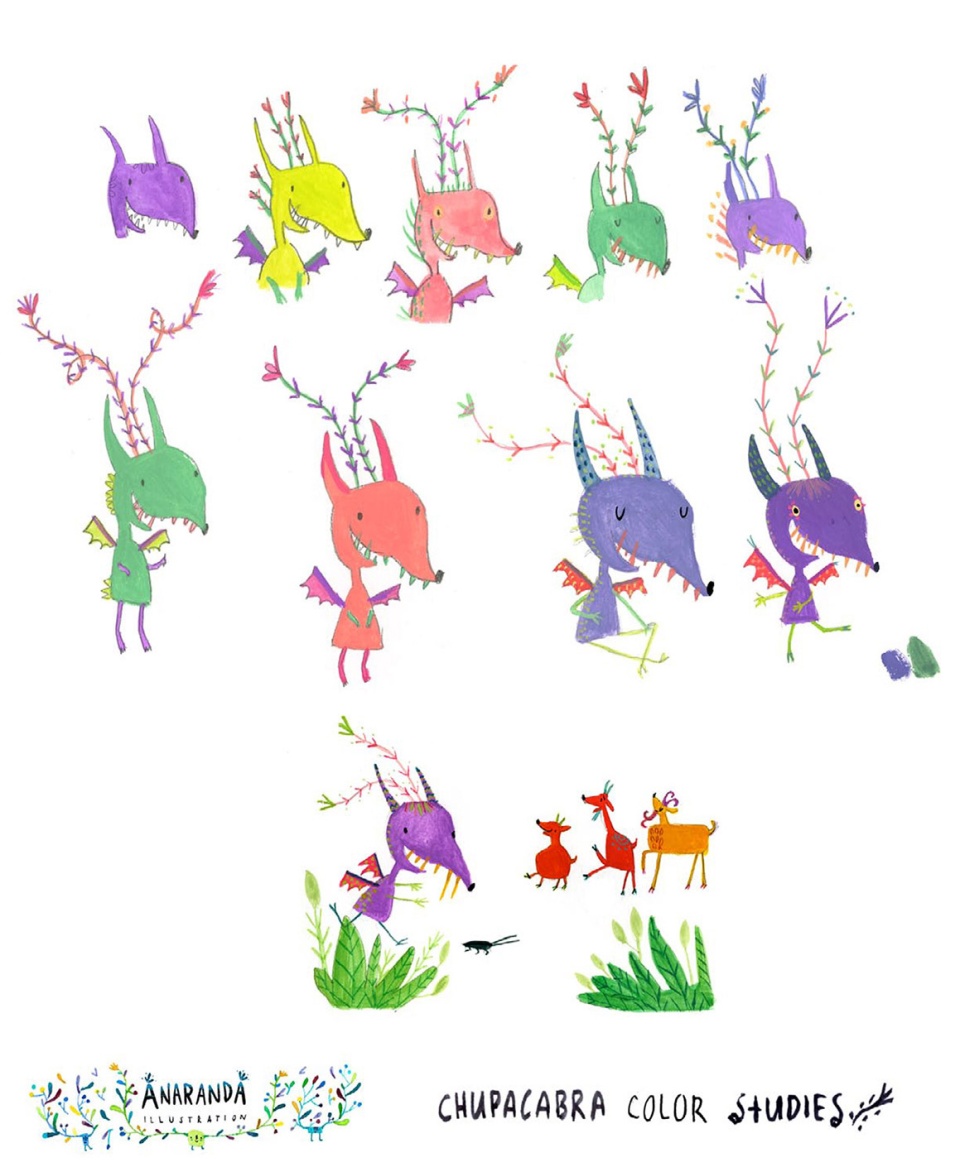
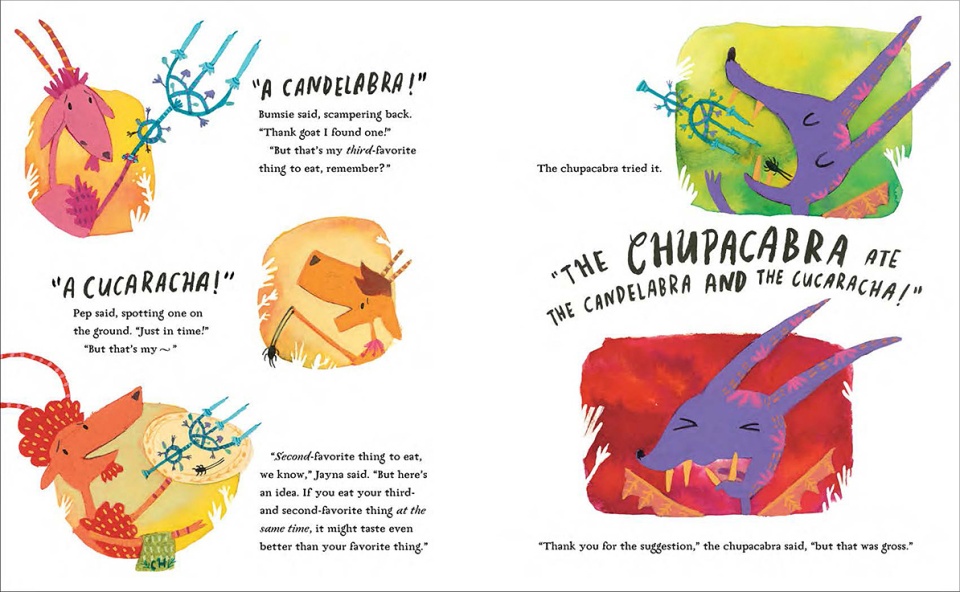
A spread from The Chupacabra Ate the Candelabra. The three goats are on the left page. The chupacabra is on the right page.
Robin: Can you tell us more about how you developed the characters? Was there a lot of back and forth with the art director and publisher to get the characters right?
Ana: The characters were very fun to develop!
The chupacabra is a very iconic character and at the same time it has not been represented as much so that people have a clear image in their minds of what it looks like. This was an opportunity to create a character that would be unique and timeless, and that children and adults alike would enjoy. I focused on designing a character that would be scary and mysterious, but funny at the same time. I must have made hundreds of sketches of different chupacabras, some of them in silhouette, line art, and color sketches with different techniques.
The goats also have very distinct personalities so there was some back and forth to get their personalities right.
Robin: The silhouettes of your characters are so distinctive and I love that you worked on some of your character sketches in silhouette. Do you do that often or just for this project?
Ana: Thank you! When working on character studies I like to work on their silhouettes first. This helps me know if they are recognizable with basic graphic elements, if their shapes are asymmetrical, dynamic and interesting overall.
Robin: Can you talk about the shadow chupacabra versus the real chupacabra? Was that an illustration note from the author or is that something you came up with?
Ana: The shadow of the chupacabra was a visual solution to create more suspense. My idea for these illustrations was to create a double narration, showing two possible sides of the chupacabra.
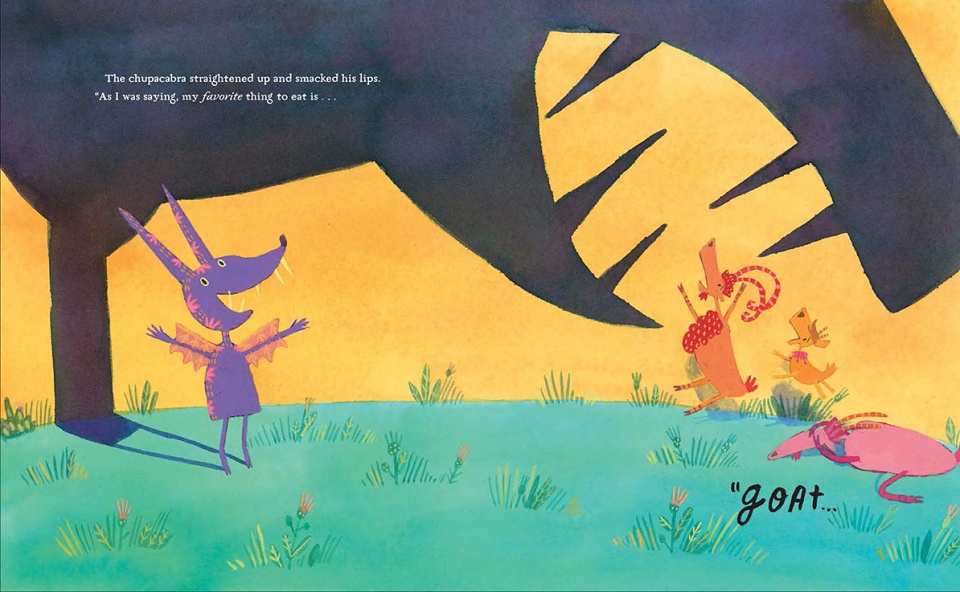
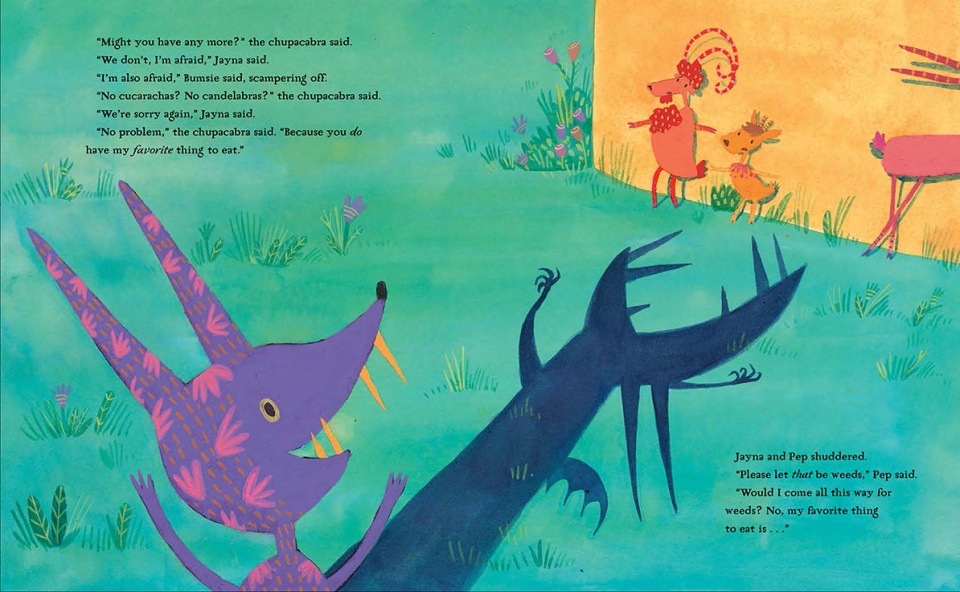
Final Spreads from The Chupacabra Ate the Candelabra. Ana used the shadow of the chupacabra to create more suspense.
Thanks Ana! For more of Ana’s work, check out her website, anaranda.com.

